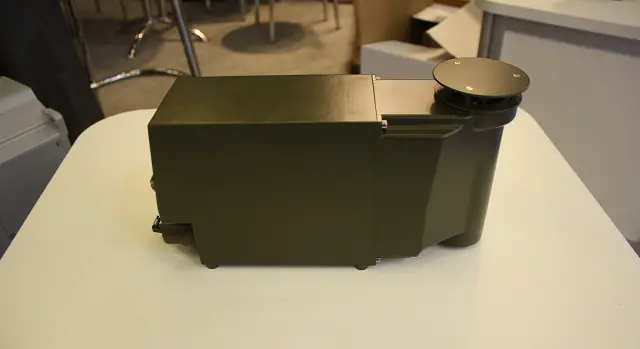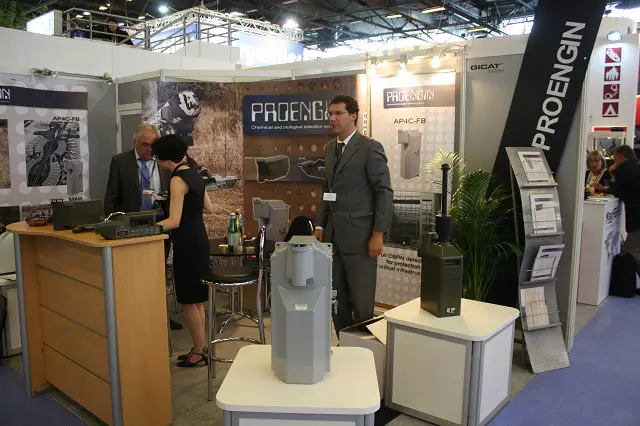After AP4C-FB , Proengin has recently launched AP4C-VB , its new combined
biological and chemical detector for mobile platforms. Proengin
masters Flame Spectrophotometry technology since 30 years and its well-known
AP2C and AP4C in more than 55 countries. MAB, based on the same technology,
has also become a reference of biological alarm detector for airborne
biological threat.
|
| Proengin
using the same technology to detect both threats, it was very natural,
to develop a single detector that would accomplish both missions.
It is noteworthy to precise that AP4C-VB is not the addition of a chemical
detector and a biological detector in the same box. This single sensor
continuously and simultaneously detects toxic gases and living particles,
and give alarm in real time.
Coming back to the customer’s point of view, CBRN detection is not
the mission of security managers of critical infrastructures or crew of
mobile platforms. CBRN detection should be an invisible operation requiring
no resources while its reliability should be flawless as lives of numerous
persons is at stake.
Flame spectrophotometry technology achieves that.
It is based on the recognition by an optical sensor of the spectrum
emitted by atoms or atomic links while burning into a tiny hydrogen flame.
This physical principle is simple and universal. Astronomers have been
using this principle to determine the nature of gases into stars since
decades.
The reliability and universality of this physical principle allows to
recognize without ambiguity the presence of some specific chemical elements
within a molecule, continuously, at very low concentrations in the air
and with a very high reliability.
|
| Chemical
detection
Sulphur, Arsenic, Phosphorus, Potassium and Sodium and nitrates are the
main elements found in the burner flame that give a immediate, and relatively
accurate information about the presence of chemical or biological threats.
Chemical threats (Chemical Warfare Agents or Toxic Industrial Compounds)
are detected as most of them contain one of several of those elements.
For example, all nerve agents include in their molecules the atom of phosphorus.
Therefore flame spectrometers can detect any type of nerve agents, known
or unknown, pure or not pure, even mixed with other chemicals in any condition
of temperature or relative humidity.
New type of agents also known as Non Traditional Agents (NTA), that are,
by definition, unknown, can be detected by flame spectrometers such as
AP4C, AP4C-V or APC-F only as their detection by other technologies such
as IMS require the knowledge of their molecular weight.
Proengin detectors have also the capability to detect an unlimited number
of toxic industrial gases containing phosphorus, sulphur, arsenic or HNO
chemical bond.
Biological detection
Biological alarm detection is more indirect and do not give the information
about the exact nature of living particles and therefore their level of
danger. Only biological analysis (by immuno-assay reaction, DNA analysis…)
can identify a living particle. However those technologies are all based
on testing samples, thus require samples and cannot be considered as alarm
detectors. When it comes to a continuous monitoring (over days or months)
of a strategic place, the main question is the rate of sampling: every
hour? Every day? Every 30 minutes?
Biological detectors based on flame spectrometry are able to help by informing
the user about a sudden and important increase of concentration of living
bacteria in the air. Proengin biological detectors (MAB, AP4C-FB or AP4C-VB)
monitor all particles and classify them by their relative content of potassium
or sodium. Any rapid change of the concentration of some potassium-sodium
signature is the evidence of a change of the concentration of some specific
living particles possibly caused by a biological attack. This information
is used to trigger a biological sampler leading to a test to identify
what has caused the alarm.
So, the detection and identification of these elements – phosphorus,
arsenic, HNO, sulphur, potassium and sodium - allow a fast and reliable
detection of most threats, whatever biological and chemical. There is
no other technology allowing a fast and simultaneous detection of thousand
of gases (or aerosols) and living particles.
For real life
Proengin has used this technology to design field detectors that can be
used in any conditions of dust, sand, or relative humidity.
For mobile platforms such as armoured vehicles, AP4C-V and AP4C-VB are
the only chemical or chemical–biological detectors that can be operated
on the exterior of the vehicle without any type of filter to be changed
or any piping driving contaminated air into the crew cabin.
For naval ships or land critical infrastructures, AP4C-F or AP4C-FB are
designed to work months or year in the same type of conditions, requiring
only one litre of water per month as a consumable.
AP4C-VB and AP4C –FB offer an important economical advantage for
users looking for a chemical and biological monitoring as they are the
only systems that do not require two detectors or two different sensors
in one system.
In addition to their high reliability and ease of use, they do not require
any attention, continuous change of spares or consumables and have a very
low power consumption.
Protection against chemical and biological threats is a difficult mission,
but these 2 instruments can be considered as valuable tools to achieve
it.
To learn more: Link
to AP4C range technical datasheet
|

 Proengin's
new AP4C-VB on display at Eurosatory 2014
Proengin's
new AP4C-VB on display at Eurosatory 2014














